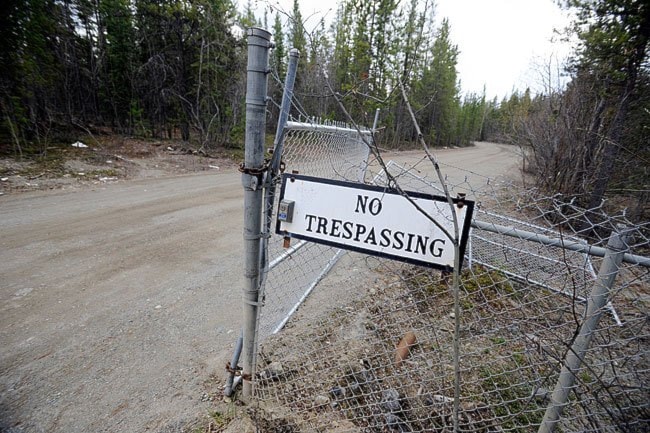Hundreds of new houses could be built on the old tank farm.
But first the land needs to be cleaned up.
It’s a huge job, said Gary Hamilton, a project director for Golder Associates, an environmental engineering firm hired by the owners of the land to run the project.
Just how big a job, Hamilton couldn’t say.
Right now the 57-hectare parcel of land, between Valleyview and Hillcrest, is still designated a contaminated site.
For years the area was used to store heating oil and diesel fuel. Over the decades, many of the 24 fuel storage tanks sprang leaks, contaminating the site with toxic hydrocarbons.
“We don’t have a lot of data on how far it got,” said Hamilton. “But basically we know it’s gone down probably 30 or more metres.”
Last week Hamilton was in Whitehorse hosting a series of meetings about the cleanup and development plans.
“We really want to get a vision for the property,” he said. “Some idea of what the public wants to see on the site.”
Three meetings were held last week, culminating in a public open house on Wednesday.
The City of Whitehorse, the Yukon government, the Kwanlin Dun and the Ta’an Kwach’an First Nation governments, local community associations and the Yukon Conservation Society, all had a seat at the table.
“Surprisingly it came together with a very similar vision for everybody,” said Hamilton.
“Nobody had any wild ideas different than what was presented.”
What they came up with was a rough sketch for a new neighbourhood.
“The vision is a combination of low-density and high-density residential development, with some commercial and industrial development maybe closer to the Alaska Highway,” he said.
It’s too soon to tell just how many units could be built.
“We don’t know yet,” said Hamilton. “The city wants to have as many units as feasible.
“They see it as a high-value property very close to the centre of town, so they’re going to push for the highest-density practical.”
And there could be even more development in the area.
Both the Kwanlin Dun and the Ta’an Kwach’an First Nations own land adjacent to the tank farm.
Not only were both First Nation governments involved in the meetings last week, but Golder has private meetings scheduled with them this week as well.
“We’re just in the planning stages right now,” said Hamilton. “They just wanted us to include their land in the planning stages.”
This isn’t the first time that the old tank farm has been considered for development.
The site was originally owned by the federal government and used to store fuel pumped up from Skagway.
A subsidiary of White Pass, Yukon Pipeline Limited, bought the 144-kilometre-long pipeline from the US military in 1958.
The pipeline closed down in 1996, and the company spent more than a decade cleaning up the tank farm.
It dismantled most of the pipeline, removed the steel oil tanks, and dug up and treated more than 1,000 cubic metres of soil.
In 2009, Yukon Pipeline Ltd. decided to abandon plans to restore the site for a residential subdivision, opting instead to bring it up to the less stringent industrial standard.
Eventually Yukon resident Mike Mickey bought the land from White Pass, which he then sold, for $4.5 million, to a group of investors, Forrest Heights Development.
The group had plans to build a large residential subdivision, but when the land was officially declared a contaminated site the project was stymied.
The developers had already paid $1.5 million for the land when it went into foreclosure last year.
In February, Yukon Supreme Court Justice Ron Veale handed the property back over to the numbered company controlled by Mickey. The judgment also allowed him to keep the money that developers had already paid.
Hamilton said he is confident that they would be able to get the contamination cleaned up to a residential standard of 1,000 parts per million.
Over the next three months, Golder will be working on a plan to deal with the contamination and presenting it to the Yukon Environmental and Socio-Economic Assessment Board for approval.
“What we’ll do is actually remove the material from the ground and treat it on the surface,” said Hamilton.
The contaminated soil will be put in lined containers. Nutrients and fertilizers will be added to help microbes break down the hydrocarbons. Nature will do the rest.
Getting it down to acceptable levels shouldn’t be a problem, said Hamilton, but it will take time.
“There is a lot of earth to move at the site,” he said. “They may be required to move some of the material off site and they’ll need to find a home for the stuff to go off site.
“It needs to be done in a phased manner.”
Estimates of how much contamination is present haven’t been undertaken yet, so Hamilton couldn’t say how long the cleanup would take.
However, he did confirm that it would cost millions of dollars to complete.
If regulators approve the project, cleanup could start as early as this fall.
Contact Josh Kerr at
joshk@yukon-news.com
